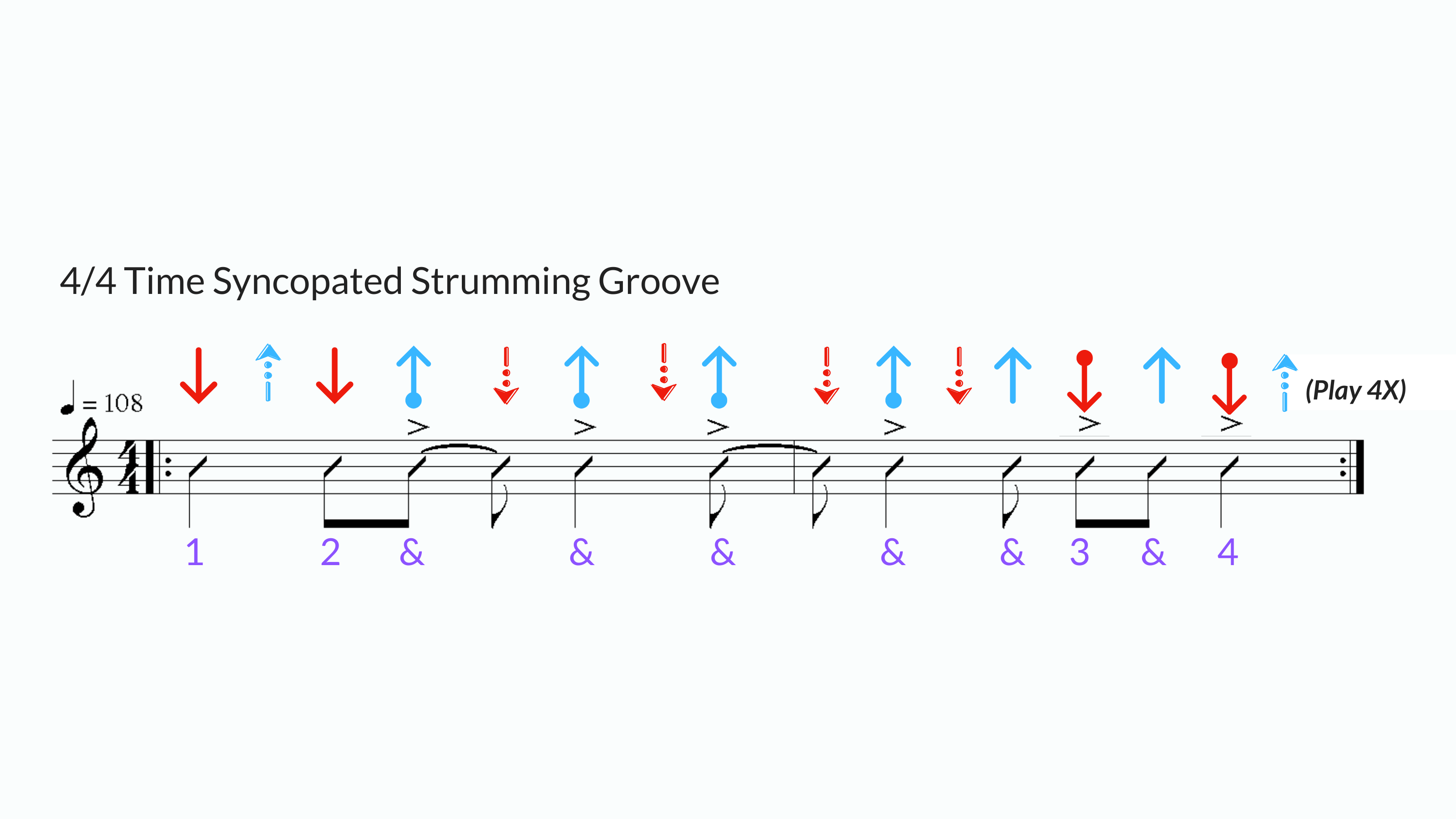
The Temptation of Syncopation with Guitar
June 21, 2023
Pro tip: please watch the short video version of this post that I link to here: www.guitarsuccess4u.com/syncopation. It will give you a much clearer grasp of what I’m sharing here.
Did you know that syncopation, in addition to being one of the most effective tools of music to engage the ear, is also one of the most precarious when it comes to playing accurately?
As strumming or flatpicking guitarists, we often come across guitar music that is syncopated…so what do we need to do when that happens, and what do we need to watch out for?
First, let’s define syncopation as: a temporary displacement of the regular beat in music, typically caused by stressing the weak beat. In other words, it’s an offbeat rhythm that sounds more unique and perhaps a little unexpected.
And syncopations happen a lot, especially in guitar music. Now, if we stress the strong beats as we play, like 1, 2, 3, 4…we’ll have a much easier time staying on track, because those are pretty easy to feel, hear, and articulate. But here’s the thing: playing on the beat isn’t always sonically interesting.
It’s often more artistic to occasionally leverage syncopation.
If you’ve played syncopations on your guitar – in just about any style, it’s possible that your tempo has been accidentally altered – and that usually means it has increased, probably without your intention, maybe even without your knowledge.
This has happened so much in my musical interactions with others, that I’ve come up with a simple saying about it. And here it is. You ready?
Every syncopation is a temptation for acceleration.
Do you believe it? I’ve worked with instrumentalists who somehow end up increasing a syncopated song’s tempo incrementally to where it’s distinctly faster than when it started. Sometimes this happens with a keyboard turnaround or a drum fill.
You can probably tell where I’m going with this – it can also happen with our strumming or flatpicking on the guitar. I say “our,” because I’ve done it too!
Let’s take a look at two short syncopated examples I’ve created for you as we discuss potential pitfalls, and some strategies I recommend to avoid those pitfalls.
Before we get into these two examples, let’s remind ourselves that quarter notes are counted with “1, 2, 3, 4,” eighth notes are counted with “1 & 2 & 3 & 4 &” and if we JUST count the offbeat 8th notes, we have “& & & &.” Right?
Syncopation with Strumming
The first example I’ve put together for you is a strumming groove involving multiple up strums, with some notes tying into other notes, creating several syncopations.

This groove in 4/4 time features a plethora of “offbeats” which are indicated by the “&” symbol. Note that four of these offbeats are accented, indicated by the accent symbols above the notes, but also the balls on the ends of the arrows.
The dotted arrows, as you might imagine, are silent. This is my special strumming system that I use in GuitarSuccess4U to help color-code ALL our strumming patterns.
Here’s the most important tip I can offer you when it comes to syncopation as you strum: keep your hand moving. All the time. If we pause, or even try to move “economically” by only strumming as the articulated notes appear, we will likely accelerate. Remember, every syncopation is a temptation for acceleration.
If you’re a detail person, you noticed that there are 10 points of contact because of this rhythm. And 10 is an even number, right? So, that means we could strum down and up and complete the cycle here, even though we’d be strumming incorrectly.
But we actually need to move down and up for 16 strums, even the ones that are silent, so we can stay on track.
Syncopation with Flatpicking
If you like to play individual notes with a pick, I’ve got one more example for you. An open A minor pentatonic syncopated riff is a great place to hang out for a moment.

And as you’ve probably seen in flatpicked notation, we have a symbol above the downstroke that looks like an industrial-strength staple, and then above the upstroke, we have a rather slender looking “V.” Feel free to articulate this, and remember to pick down on the beats and up on the offbeats, whether voiced or silent.
Closing Thoughts
Now, there will be exceptions to what we’ve talked about today, but the vast majority of our playing will be cleaner and more precise if we follow this approach.
Why am I so particular about strumming or picking down on the beats, and then coming back up on the offbeats, whether voiced or not? It’s because I really don’t want us to even have to think about it.
If you’ve experienced Guitar Serious Fun Episode 48: “Strumming: Sloppy or Skillful?”, you know that once we’ve got this figured out, we can move on to making music.
Speaking of, I’m sure there’s a song at your fingertips that has syncopation in it, whether strummed or flatpicked. If you look closely at your song, you’ll find some instant application for what I’ve shown you today.
Until next time – pursue skillful playing, and remember: don’t give in…to the temptation of syncopation.
And don’t forget to check out www.GuitarSuccess4U.com, where we go deeper with all kinds of tools, including strumming on multiple levels!
Thanks for hanging out with me, and I’ll see you next time!
ABOUT ME
David Harsh
Singer, Guitarist, Teacher
Welcome to a blog designed to enhance your guitar journey as you offer your gifts to the Lord.

© 2023 GuitarSuccess4U a ministry of David Harsh Ministries.



